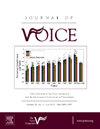The Role of Vibrato in Group Singing: A Systematic Review
IF 2.5
4区 医学
Q1 AUDIOLOGY & SPEECH-LANGUAGE PATHOLOGY
引用次数: 0
Abstract
Introduction
Arguably one of the most controversial features of the singing voice, especially in a choral context, is the phenomenon of vibrato. Numerous pedagogical articles, mostly written by experienced choral singers or directors, discuss the importance of vibrato, sharing anecdotal insights about its control (often advocating reduction) in choral blend and vocal health.
Objectives
This systematic review aims to identify the main questions posed in the empirical study of vibrato during group singing, and how they have been addressed to date through empirical investigations.
Methods
The Preferred Reporting Items for Systematic Reviews and Meta-Analyses was employed for this review. The review team consisted of the two authors. A data extraction form was designed to capture information about the participants (including age, gender, music and singing experience), study methods, experimental procedures, outcome measures, and statistical findings.
Results
Seventeen studies were included in the review and revealed that (a) relatively few empirical investigations have studied vibrato in vocal ensembles; (b) the majority focused on vibrato production rather than perception; (c) methodological approaches include Synthesis, Multi-track recordings, Stereo/Binaural recordings, and Lx/Contact recordings; and (d) the studies focused on the main themes of Adjustment, Identification, Interaction, Intonation, and Style.
Conclusion
With the current body of literature, it is not possible to draw general conclusions around vibrato behavior during group singing. However, the review highlights the main subareas of interest and valuable methods which have been established and through which future research can collectively shed further light on the role of vibrato in choral singing.
颤音在集体歌唱中的作用:系统回顾
简介颤音现象可以说是歌唱声部(尤其是合唱声部)最具争议性的特征之一。许多教学文章(大多由经验丰富的合唱歌手或指挥撰写)都讨论了揉弦的重要性,分享了在合唱融合和声乐健康中控制揉弦(通常主张减少揉弦)的轶事:本系统综述旨在确定集体演唱时揉弦实证研究中提出的主要问题,以及迄今为止如何通过实证调查解决这些问题:方法:本综述采用了《系统综述和元分析首选报告项目》(Preferred Reporting Items for Systematic Reviews and Meta-Analyses)。综述小组由两位作者组成。我们设计了一份数据提取表,用于收集有关参与者(包括年龄、性别、音乐和歌唱经验)、研究方法、实验程序、结果测量和统计结果的信息:综述包括 17 项研究,结果显示:(a) 研究声乐合奏中颤音的实证调查相对较少;(b) 大多数研究侧重于颤音的产生而非感知;(c) 研究方法包括合成、多轨录音、立体声/双耳录音和 Lx/接触录音;(d) 研究侧重于调整、识别、互动、音调和风格等主题:从目前的文献来看,还无法就集体演唱时的揉弦行为得出一般性结论。然而,本综述强调了主要的兴趣子领域和已经建立的有价值的方法,通过这些方法,未来的研究可以共同揭示揉弦在合唱中的作用。
本文章由计算机程序翻译,如有差异,请以英文原文为准。
求助全文
约1分钟内获得全文
求助全文
来源期刊

Journal of Voice
医学-耳鼻喉科学
CiteScore
4.00
自引率
13.60%
发文量
395
审稿时长
59 days
期刊介绍:
The Journal of Voice is widely regarded as the world''s premiere journal for voice medicine and research. This peer-reviewed publication is listed in Index Medicus and is indexed by the Institute for Scientific Information. The journal contains articles written by experts throughout the world on all topics in voice sciences, voice medicine and surgery, and speech-language pathologists'' management of voice-related problems. The journal includes clinical articles, clinical research, and laboratory research. Members of the Foundation receive the journal as a benefit of membership.
 求助内容:
求助内容: 应助结果提醒方式:
应助结果提醒方式:


